We're thrilled to announce we've been nominated for a Webby Award! View our entry and vote.
How to Build a Mid-Level Giving Program - Part 4 of 4
How to Design a Communications Plan for Your Mid-Level Giving Program
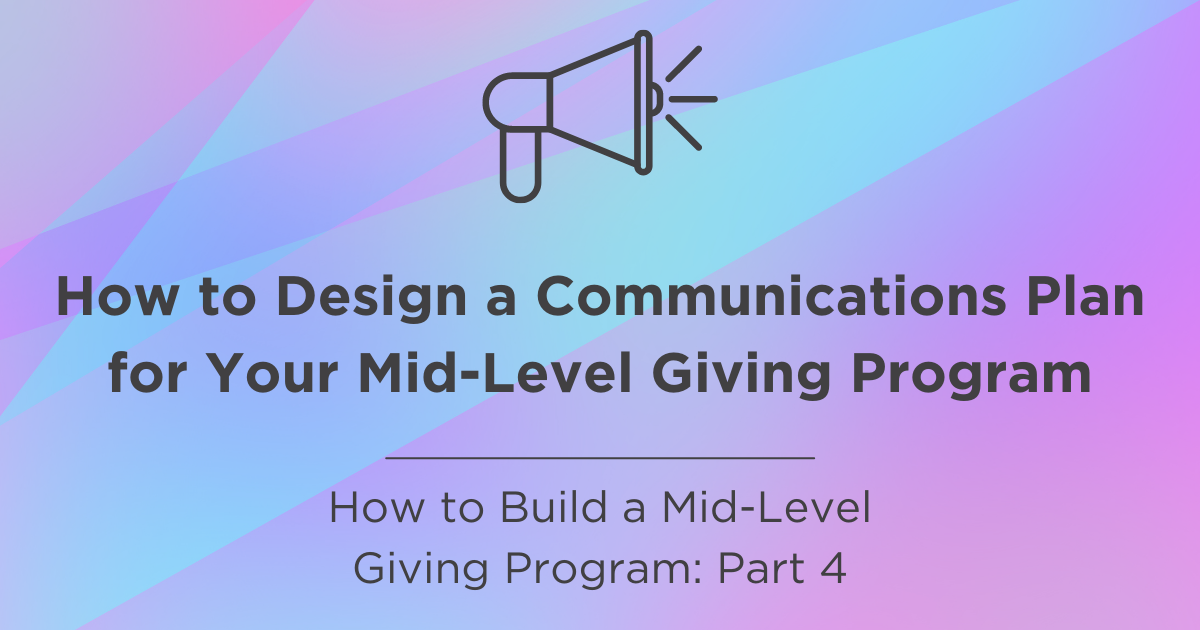
Download all 4 Parts of our eBook
In earlier installments of this series, we established how mid-level donors are a special class. They’re more loyal (and thus more predictable) than other groups, and they offer a pool of supporters to funnel into your major gifts program. They deserve a communications plan tailored to their unique characteristics, so we’ve identified factors to keep in mind as you design a plan meant to speak to them.
But first, a reminder. In all your communications — from your mass-market audience engagement to your major gift donor cultivation — remember the importance of personalization. As we noted previously, 59 percent of donors surveyed by Accenture in 2017 said personalization would raise their donations by 10 percent, while 8 percent said it would increase their contribution by up to 50 percent more. It literally pays to personalize your communications, but you can’t just add the recipient’s name in a greeting and call it a day. Effective personalization means tailoring your message to a constituent’s unique interests — why they give to you, their donation or volunteer history, where they live, and so on. With the right data in place, the possibilities are endless.
And, because you want to groom your mid-level donors for the high-touch, ultra-personal communications that characterize relationships at the major gifts level, acclimating them to hyper personalized outreach before they move to that level is key.
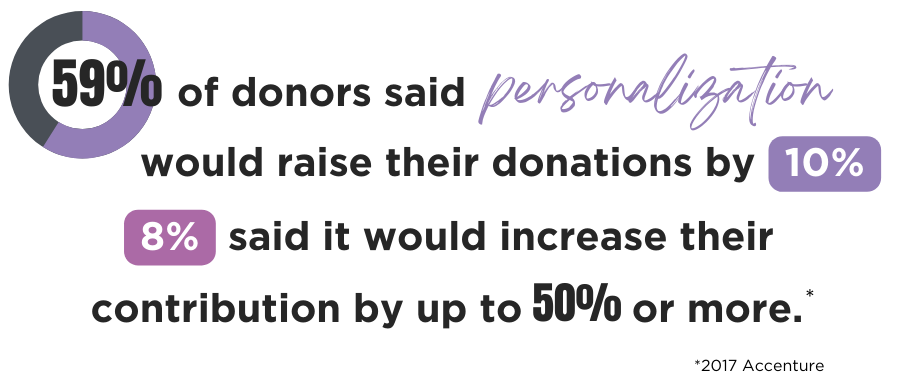
Emphasizing Community Through Branding
Also important to mid-level donors is community and connection. We’ve seen it be especially meaningful to this group of donors, which is why a branded program can be so beneficial.
And, by naming it, the program moves from being an internal initiative to one that’s externally recognized. If yours was an astronomy association, for example, you could call your mid-level program Space Nation, a play on “space station,” and inject a bit of whimsy and personality to the group.
Branding also provides an opportunity to craft a special logo that quickly communicates the program visually. You can reinforce this visual message by repeating it in your copy: “Space Nation, unite! We’re gathering this July for a nighttime viewing of the XYZ Comet as it passes by Earth not to be seen for another 82 years. Come join fellow members of Space Nation as we…“
Taking It Slow
But remember: You don’t have to create a special society or group for your mid-level donors. You may already have a branded monthly sustainer program, for instance, or one reserved for those super contributors who donate transformative amounts to your organization. Creating another branded donor program could generate one more than is necessary.
 In other words, it’s OK to keep your mid-level donors in direct marketing sent to your annual fund. You may only need to change one or two touches that elevates their experience from the one designed for your mass-market audience. You might, for example, alter the frequency of your communications — in addition to your monthly outreach, maybe you send a quarterly newsletter containing exclusive information just for them and refrain from donation appeals. “Be brave about limiting your asks,” says Kristin Priest, vice president of client strategy at Pursuant. “Make them really good and deeply impactful.”
In other words, it’s OK to keep your mid-level donors in direct marketing sent to your annual fund. You may only need to change one or two touches that elevates their experience from the one designed for your mass-market audience. You might, for example, alter the frequency of your communications — in addition to your monthly outreach, maybe you send a quarterly newsletter containing exclusive information just for them and refrain from donation appeals. “Be brave about limiting your asks,” says Kristin Priest, vice president of client strategy at Pursuant. “Make them really good and deeply impactful.”
And some of your mid-level donors may have indicated that they’d prefer less, not more, communication from you. Honor those requests, as uncomfortable as that may be. “It can be scary, because no one wants to turn off their email or direct mail marketing,” says Ryan Carpenter, vice president of client success at Pursuant. “I’m not saying offer that up, but whenever we have a chance to talk to someone, we always want to understand their preferences.”
On the positive side, when those requests have been fulfilled, Pursuant found that donors “gave more on average every year,” says Carpenter. “I can’t remember a time when that wasn’t the case.”
Of course, size also matters. The number of donors who meet your criteria for a mid-level program could be too large for your mid-level officer or team to transfer to a personal communication track. Instead, identify as many of the highest priority donors as you can manage and funnel them to that track. “If it’s everybody on your mid-level list, fantastic,” says Carpenter, ”but if it’s only twenty-five of your best mid-level donors, that’s a great start too.”
Again, it’s OK to move more slowly. You don’t need to make drastic changes, and you don’t want to stray too far afield from the communication tactics that brought your mid-level donors to where they are today.
Data-Powered Communications
To create your list of mid-level donors, you hopefully leveraged data and technology. Now, you can use the same tools and platforms to glean insights about your mid-level donors. Do they tend to live in certain types of areas — rural versus urban locations, for example? Have they participated in surveys where they told you which of your programs interest them? For instance, if your nonprofit offers animal protection and rescue services, did they show greater interest in puppy adoptions versus programs for fostering kittens?
This data can inform your communications, both visual and written. If you know which donors showed interest in puppy adoption programs, for example, you might use images of puppies in your direct mail campaigns to them, and your copy could tell the story of an abandoned puppy who found a home with a family that had recently lost their beloved hound.
That’s an example of data in service of personalization. At the very least, you always want to use data to automate a personalized greeting. “Dear Tommy” versus “Dear supporter” will always land better than a generic salutation, so try whenever possible to greet donors by name.
Watch What You Say: You/Me/We Language
Are donors at the center of your communications? The language you use in your outreach will answer that question. Here’s what we mean:
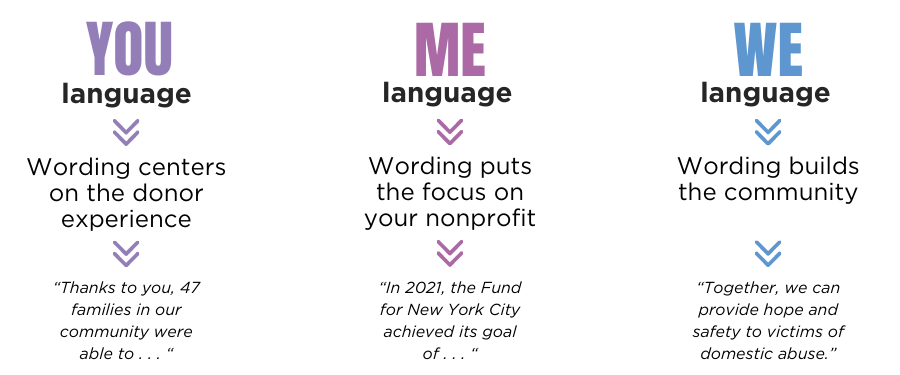
You Language
“Thanks to you, 47 families in our community were able to . . . “
This kind of wording centers the donor experience. It shows the impact their contributions and involvement have had. You can complete the sentence with quantifiable metrics, and don’t worry—you don’t need to write a novel. It just has to illustrate the effects of the donor’s participation and support.
Be sure that it doesn’t feel transactional, though. “It’s not, ‘Here’s what your $300 will buy.’ That’ll make them feel like customers,” says Priest. “It’s more about something they can help accomplish, not purchase.”
Me Language
“In 2021, the Fund for New York City achieved its goal of . . . “
This kind of wording puts the focus on your nonprofit. It’s traditional marketing language that explains why donors should support your organization. “It’s what comes most naturally to organizations, and it’s worth keeping because it builds trust,” Priest says. Nonprofits often overuse it, however, so temper where and when you apply it.
We Language
“Together, we can provide hope and safety to victims of domestic abuse.”
This kind of wording builds community, which, as we noted earlier, is a meaningful element for mid-level donors.
In fact, in research and testing conducted by Pursuant and others in the field, we find that the you/me/we language is important in ensuring donors at all giving levels feel a strong sense of ownership in helping produce clear solutions. For organizations that may not have a dedicated mid-level giving officer strategizing curated experiences, ensuring the right voice is critical because their print and digital communications have to speak for them.
“Our hypothesis is that the mass market and annual fund groups benefit from a more general level of information and engagement, while major donors have the benefit of really personalized experiences and relationships,” says Whitney Norman, vice president of client solutions at Pursuant. “So, at the mid-level, the significance of this you/me/we language is elevated.” Besides the importance of community that we discussed earlier (“Together, we . . . “ language, for example), mid-level donors want to understand the impact that their contributions have — “You made XX happen” language. When organizations miss the mark by using me-focused language (“ABC nonprofit accomplished . . .,” for instance), mid-level donors are at higher risk for feeling uninspired and disengaging.
Tying It All Together: Key Communication Elements
While the list below isn’t exhaustive and may not apply to every message, it offers good guidelines for what your communications should encompass.
- Personalized greeting. Beyond including this in the salutation, incorporate it into the body of your communications, be it email, postcard, or web page. The message should be tailored to the donor throughout the copy. We can’t stress the importance of personalization enough.
- The hook. What will “hook” your reader in — why are you writing? This is where mid-level communications teams can struggle, so create a communications calendar or draw from an existing one developed by colleagues in major gifts. That will help you understand, build on, or reference the current donor experience. Think, for example, of what they may have recently experienced through channels like:
- Social media. Is there a phenomenon like the ALS ice bucket challenge or viral post that your organization can jump on? Is there a social media campaign your own nonprofit is currently running?
- News reference. This is a good way to show that your organization is making waves — something like, “Did you see the [put your local TV station or other media outlet here] story about our [put your initiative or program here]?”
- Direct mail. What have your teammates in development and marketing sent recently?
- Events. Is there an upcoming event that you can call their attention to?
You may be writing a simple stewardship or thank-you email or letter and won’t need a hook, but these can be good prompts when you’re trying to cultivate a relationship.
- Donor impact. When you’re writing in response to a gift, thank you isn’t enough. Tell them the impact that their donation will or did have. Sometimes that will be statistics or other success markets; sometimes the impact is more abstract: “I wish you could have been in the room with me when I told our doctors and nurses that this year’s donations — your gift — means we can continue serving the unhoused population of downtown Los Angeles free of charge.”
- The perk or special experience. Is there a benefit or special offering you can extend to draw them closer to your organization — maybe a resource, invitation to a mid-level-only webinar, or link to a landing page built just for them? The key is limited access. You want to surprise and delight your mid-level donors, but neither does the offer need to be hidden or secretive. For instance, are there aspects of the offer that can be highlighted on social media to provide public recognition? “You don’t always have to build an individually customized experience, but you can craft one that’s curated,” Priest says.
Of course, it can be difficult to identify new or appropriate benefits each time, so consider swapping this section out with news about an upcoming drive or other action your organization is undertaking.
- Closing. Offer to be a resource if they have questions or need assistance accessing their benefits. Share your email and cell phone number.
Now let’s look at a couple of examples that show these communication elements in action.
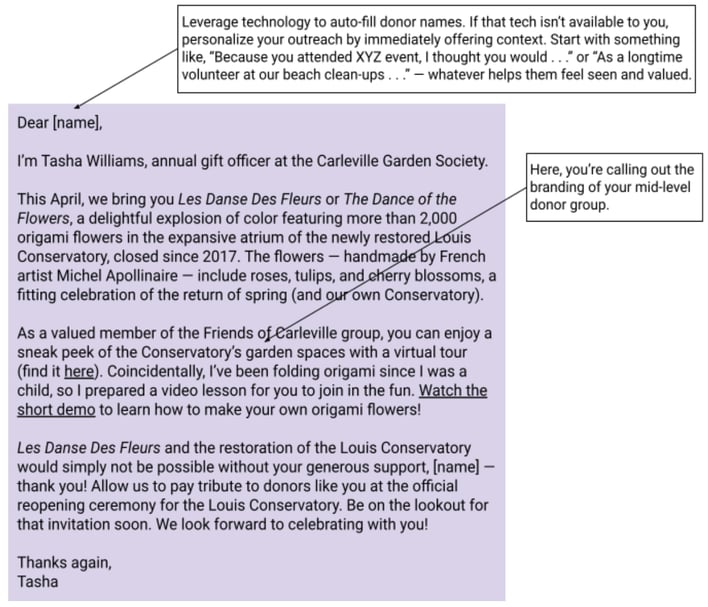
In this particular case, the gift officer just happened to be an origami enthusiast, so her team took advantage of her expertise and transformed it into a special offering, along with the virtual tour. It’s a great example of developing creative benefits for mid-level donors without expending a big cost outlay. (Note, too, how the email fueled anticipation for the invitation to the reopening ceremony.)
In the next example, the appeal is more modest but authentically human, which you find in the conversational, less formal voice and tone.
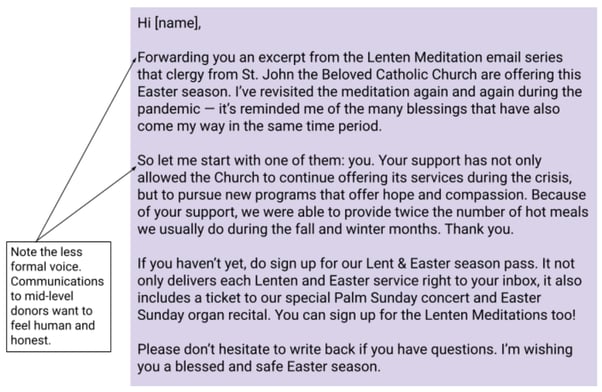
Both are simply examples. Refer to them as you develop your own communications and, when possible, incorporate as many of the pointers we’ve shared here. We’d love to hear about your experience, so don’t be shy about sharing your excitement over positive growth or lamenting more sluggish responses. With decades of experience under our belt, we’ve been through the highs and lows of fundraising and are here to celebrate your wins, as well as problem-solve thorny issues.
Feeling overwhelmed or short-staffed?
Pursuant is a fundraising and marketing agency that exclusively serves the non-profit sector. Our seasoned veterans serve as an extension of your team. Leveraging decades of practical experience and powered by GivingDNA, our exclusive donor engagement platform, we elevate the way you discover, segment, and engage donors to drive generosity and loyalty. Interested in learning more about how we can support your mid-level giving efforts? Let’s connect!
